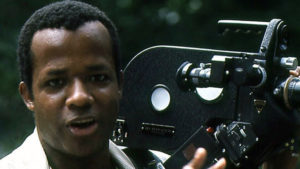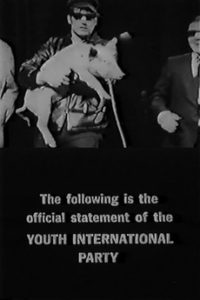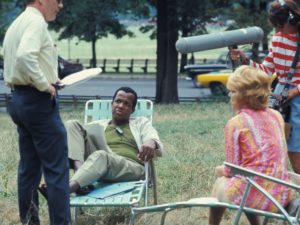 Program Notes: Rooftop Cinema
Program Notes: Rooftop Cinema
Yippie! | Youth International Party | US | 1968 | 10 minutes
Symbiopsychotaxiplasm: Take One | William Greaves | US | 1968 | 75 minutes
Rooftop Cinema, Madison Museum of Contemporary Art, Friday, June 15, 9:30pm»
As the “party with a purpose” continues at the Madison Reunion conference downtown and on campus this weekend, Rooftop Cinema showcases two films that remind us how things have changed and how things have stayed the same since 1968.
In her essay on Symbiopsychotaxiplasm: Take One, the critic Amy Taubin points out that in 1968 the film and theater world oscillated between two ideals: the auteur and the collective. Tonight’s films illustrate both ideals: the potential of an individual artist to bring his or her unique vision to the screen, and the possibility of individuals to come together to take collective action.
 The first film documents collective action and is itself a product of collective action. Yippie! was produced as the “official statement” of the Youth International Party, known more popular as the “Yippies.” The most well known Yippies included Abbie and Anita Hoffman, Jerry Rubin, Nancy Kurshan, Paul Krassner, and the folk singer Phil Ochs. Their irreverent fusion of street theater and politically themed pranks earned them another nickname, “Groucho Marxists.” Yippie! documents several Yippie protests staged during the lead up to the 1968 Democratic National Convention in Chicago.
The first film documents collective action and is itself a product of collective action. Yippie! was produced as the “official statement” of the Youth International Party, known more popular as the “Yippies.” The most well known Yippies included Abbie and Anita Hoffman, Jerry Rubin, Nancy Kurshan, Paul Krassner, and the folk singer Phil Ochs. Their irreverent fusion of street theater and politically themed pranks earned them another nickname, “Groucho Marxists.” Yippie! documents several Yippie protests staged during the lead up to the 1968 Democratic National Convention in Chicago.
As depicted in the film, the Yippies nominated “Pigasus the Immortal” as their candidate for president, and demanded that the 145-pound pig be treated as a legitimate candidate. Pigasus was purchased from a local farmer by Ochs. Seven Yippies, including Rubin and Ochs, were arrested and charged with disorderly conduct after Rubin’s attempted “acceptance speech” for Pigasus.
While the film was produced “by and for Yippies,” it was eventually distributed by the radical documentary collective Newsreel, who brought the film to a wider audience at campuses across the country. Soon radical filmmaking moved away from the irreverent style of films like Yippie! as filmmakers sought a new film language to address their social and political concerns.
Filmmaker William Greaves (1926-2014) did not come from this tradition of radical or experimental filmmaking, but his unique vision produced one of the most unconventional films of the late 1960s, Symbiopsychotaxiplasm: Take One. As an African-American actor and filmmaker, he was frustrated by the lack of opportunities in American film and television. In 1952 he moved to work at the National Film Board of Canada, led by the pioneer documentarian John Grierson. Eventually public television opportunities brought him back to the United States, and at the time he shot Symbiopsychotaxiplasm he had been appointed executive producer of Black Journal, a public affairs program produced at WNET by National Educational Television.

Key to the pleasure of watching Symbiopsychotaxiplasm is discovering just what the heck is going on. This is suggested in Greaves’ production notes to himself regarding how to handle the cast and crew: “Refuse to give a total explanation of the film! First of all, it is impossible anyway, due to its complexity. Give only as much of an explanation as will satisfy the performers and film crew. To give more will kill the truth and spontaneity of everyone.” In that spirit, these program notes will not reveal any details about the film itself.
According to Taubin, Greaves shot roughly fifty-five hours of footage for the Symbiopsychotaxiplasm project, which he intended to transform into five films. But after Take One failed to secure a theatrical release, Greaves shelved those plans. Take One only had occasional screenings after its premiere in 1971. Years later, the actor Steve Buscemi and filmmaker Steven Soderbergh saw the film and eventually helped Greaves produce a sequel, Take 2 1/2, which combines footage shot in 1968 and 2003. In 2006, the Criterion Collection released a 2-DVD set, Symbiopsychotaxiplasm: Two Takes by William Greaves, which also includes a documentary about Greaves and his career.

Rooftop Cinema is a program of MMoCA’s education department and is curated by James Kreul, with technical support provided by Tanner Engbretsen. MMoCA’s film programming is generously funded by maiahaus and Venture Investors, LLC.